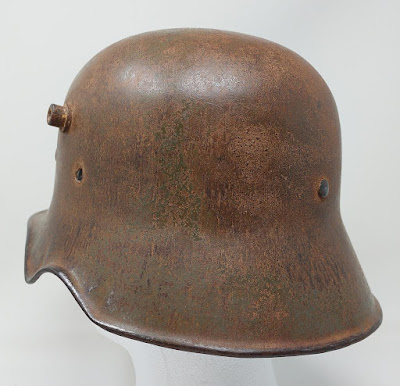The Global War on Terrorism replaced the Cold War as America focused on a new and deadly enemy. The tragedy of 9/11 shocked America and altered the freedoms that Americans have taken for granted for over two centuries.
One of the countries where the United States was fighting was Afghanistan, which is where this helmet most recently served with the old Afghan Army.
Following the First World War, victorious allies confiscated enormous amounts of German and Austrian war material. Much was scrapped, and some was re-used, as in the instance of this helmet.
As time marched on and the Afghans moved to slightly more modern helmets, most of the WWII models were put into storage, including very large numbers stacked in caves. During American involvement there, one of the many civilian contractors working with the US military, visited one of these caves prior to it being sealed with explosives.
He managed to salvage five of these helmets...goodness knows how many are still buried in that cave.
The helmet is the German m.18 "cut-out helmet" of WWI.
It is referred to as the cut-out because of the scallop in the skirt.
For many years there was much conjecture regarding the purpose of this cut-out. For many years it was referred to as the "cavalry helmet" based, I believe, on a war-time photo of a German cavalryman wearing this helmet. Some helmet collectors still cling to the "cavalry helmet" idea, though it has pretty much been discredited. Similarly discarded is the idea that the cut-out was an attempt to make the helmet more accommodating to the receivers of field-telephones; an idea now generally abandoned.
Most collectors now agree that the cut-out was simply to improve hearing on a noisy battlefield. The skirt of this helmet's progenitors - the m.16 and m.17 has a full skirt which covered the ears, impairing the soldier's hearing.
The "cut-out" helmet or "ECO" (ear cut-out) m.18 was produced in comparatively limited numbers compared to the m.16 and m.17, making these a rarity and a "white whale" for most collectors.

On the side of the helmet is the white, green, black and red insignia of the Afghan army, which is still in use today.
Quite a bit of the original Afghan paint remains.
The severe pitting in the dome leads me to believe that this helmet was stored upside down, trapping water within it.
As with the other models of German helmets, the size and manufacturer's mark are stamped into the interior of the side of the skirt.
The rim is neatly folded, as it is on all German helmets from the First World War.
A split-pin affixed the leather headband, of which only a tiny fragment remains.
The interior washer which affixes the ventilation lug.
Holes were somewhat crudely punched into the shell to affix the metal insignia.
The m.18 compared to the m.17. Note that unlike the m.17, the m.18 has no exterior rivet to fasten the chinstrap, instead, the m.18 chinstrap was fastened directly to the metal liner-band.
Similarly, there is no mounting post on the inside of the skirt as there is in the earlier models.
Here are some shots of this model in action:
A German flamethrower operator in WWI
Afghan soldiers, the second from left is wearing the ECO helmet
Afghan soldier
Even Finland utilized the cut-out m.18 in their war with the Soviets.
Prior to, and in the early years of, the Second World War, the m.18 cut-out could be seen as a transitional helmet in the German army.
These helmets are very had to come by, and I was resigned to the fact that I'd very likely never have one, but this one popped up on ebay, and when the smoke and dust from the bidding war ended, I was victorious. I am very happy and very fortunate to have it on the wall.
See you next time with another cool helmet from the collection.
Mannie
































No comments:
Post a Comment